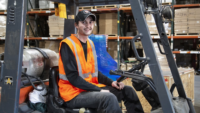Employee safety is an important factor in every industry. According to the International Labor Organization, more than 2.78 million people die as a result of occupational accidents or work-related diseases each year. The organization tracks a further 374 million non-fatal work-related injuries a year, as well. High-risk applications — where people are operating heavy machinery, maneuvering large loads, or working in confined spaces, overhead or at heights — account for a significant percentage of these injuries. The U.S. Bureau of Labor and Statistics reported nearly 200,000 non-fatal occupational injuries and illnesses in the construction industry alone in 2018.
Though refractory installation techniques and equipment have evolved over the years to offer increased safety, there are still a number of risks involved with the process. Cultivating a culture of safety on the jobsite is key to making sure every shift ends without incident. To help further on-site efforts, original equipment manufacturers have often been at the forefront of safety initiatives in the refractory industry, providing innovative equipment that addresses the specific risks of refractory installation.
Working with these industry-leading manufacturers can result in a number of safety- and productivity-enhancing options specialized for refractory applications. Additionally, they provide a safety-conscious partner for continued support.
A Culture of Safety
An abundance of equipment options means contractors and facility managers can easily incorporate safety enhancement into their current process. However, to build a culture of safety, it’s important to create partnerships with manufacturers that share the same commitment. Rather than simply meet prescribed standards, industry-leading manufacturers strive to exceed these guidelines. They carefully engineer and test products as well as offer continued support long after the initial purchase, ensuring long-term safety.
Design
A quick comparison of design features can help evaluate a manufacturer’s commitment to safety.
Start with materials. Equipment manufactured with 6061-T6 aircraft aluminum offers the best strength-to-weight ratio, providing the durability of steel at a third the weight. However, welding aluminum products requires certified aluminum welders and specialized equipment, limiting its use by in-house engineers and certain manufacturers.
Incorporating this lightweight material into designs, though, has a number of safety benefits. Modular pieces created with heavy-duty aluminum are lighter and easier to assemble, reducing risk of physical strain. Additionally, the material’s strength can produce a high safety factor when combined with high-quality engineering.
For example, some parts of the world allow workers to enter before refractory and coating is removed. These operations can employ safety cages and personnel tunnels available from a number of manufacturers, but not all models offer the same degree of protection. A safety cage manufactured with 6061-T6 aluminum, is strong enough to protect workers from debris up to 140 kilograms (250 pounds) falling from a height of up to 2.4 meters (8 feet), while still being light enough for two people to maneuver.
Additionally, industry-leading manufacturers also use aircraft grade aluminum for custom-designed kiln access ramps. This equipment takes into account challenges presented by an operation’s burn floor, cooler and kiln and can support as much as 6,804 kilograms (15,000 pounds) live load, increasing protection for workers and equipment moving across the ramp.
A review of other standard features can also help differentiate more safety-conscious manufacturers. With the majority to refractory installation contractors opting to use a bricking machine, there are a number of models in operation around the world that offer varying degrees of safety. Originally designed to reduce physical strain and safety risks compared to traditional installation methods, such as pogo sticks, mechanical jack screws, gluing, and jack and timber, many decades-old, first-generation bricking machines can still provide basic protection for workers, as long as they are well maintained. However, newer models provide the most innovative and cutting-edge technology, such as adjustable dual-arch systems with pneumatic cylinders to push bricks into place, greatly reducing the risk of injuries from unsupported material overhead. Machines featuring ergonomic design elements further increase worker comfort and safety. For example, some models offer a cut-away section for unobstructed access to the keying area to increase ease and visibility for closing out a ring. Additional safety features are also available from specialized manufacturers, including non-slip decks, dual braking systems and fall guards.
Other design elements contractors should look for include fall guards, railings, kick plates, non-slip surfaces and stainless-steel netting. Standard inclusion of these features indicates engineers have carefully considered real-world applications during the design phase and developed products with the human element in mind. Dropped tools, pinch points, distracted workers and other common jobsite mishaps are given as much attention in design as overall function. This intuitive engineering requires a thorough understanding of not only refractory installation techniques, but the men and women on the jobsite, and is often a hallmark of equipment from manufacturers with a long history in the industry.
Custom design is also worth mentioning when it comes to evaluating equipment safety features. Working directly with a manufacturer for tailor-made equipment means site-specific concerns can be addressed in design. For example, a factory in South Carolina needed to safely transport materials using a narrow ramp. To make sure there was no risk of accidently driving equipment over the edge and falling into the cooler, the manufacturer included a 406-millimeter (16-inch) curb guard on its custom-engineered access ramp.
Testing
In addition to thorough design, comprehensive and continuous testing is another way top-tier manufacturers ensure equipment meets or exceeds safety standards.
A number of live and simulated tests are performed throughout the design and manufacturing process. With a bricking machine, for example, stress modeling and static load testing is used to identify any design flaws that could lead to equipment failure. Movable parts, such as brick arches using a trolley system, are also tested in real-world scenarios to ensure safety. A drop test will determine if safety cage crumple zones will perform within specification. Each product is put through a battery of tests based on its function.
While some manufacturers are satisfied if equipment passes initial tests, others continue to analyze and adapt. Incident reports from around the world are reviewed and recreated to see if a similar problem could arise. Additionally, safety-conscious manufacturers work with customers to make sure their concerns are considered from every angle and the products are rigorously tested to everyone’s satisfaction.
Ongoing Commitment to Safety
Some manufacturers take their commitment to safety a step farther. In addition to continued product testing, they offer on-site equipment inspections, parts and service to ensure long-term safety.
For bricking machines, manufacturers recommend inspections every three years or five uses. After eight years, ongoing annual inspection is encouraged. A technician conducts a visual evaluation as well as dye penetration tests on all welds. Depending on the model, they will also check additional features, such as valves on machines with pneumatic cylinders. Based on results, the technician will recommend repairs and replacements that should be performed as well as advise on any safety upgrades available for a particular machine.
These inspections can also be turned into a learning opportunity. Some manufacturers can combine on-site evaluations with training for plant personnel and contractors covering general maintenance, safety and storage procedures. Over time, crews change. Those on hand for the initial commissioning — where assembly, maintenance and storage requirements were originally outlined — may not be the same faces three years later. Taking advantage of continuing education opportunities is key to upholding a culture of safety.
Additionally, top-tier manufacturers offer premium parts and service support. From yearly maintenance to parts tracking, partnering with a reputable manufacturer ensures equipment is ready for operation during unscheduled kiln downtime. A lasting partnership with these manufacturers means facilities and contractors have access to original parts and expert advice to optimize safety and efficiency.
Lasting Safety Partnerships
A safe workplace requires commitment, awareness, training and high-quality, well-maintained equipment. Partnering with a manufacturer that factors safety into every aspect of its products – from design, to testing, to aftermarket support – means everyone can feel confident each shift will end without incident.




